This 4x8 low fired ceramic tile was soaked then layered with an 1/8 inch of, 1:2, 2 large sand and 1 wet lime. This is not a true 'Trullisatio' or 'Scratch' first rough coat which would be the first of three mortar layers. Nor is it a true 'Arriccio' or 'Brown' rough coat, the second rough coat. But it is as thick as a brown coat. Understand that the tile is a very stable support and smaller portable frescos are fine without three coats. Fresco dries from the top down, lower coats preserve the water supply. A 12 or 18 inch tile is small enough to finish in a day.
The next day, 5-21-4, I layered on an 'Intonaco' coat of 1 lime and 1 small white sand, 1/8 of an inch thick to an 8x8 inch tile.
They didn't have any crushed limestone anywhere in the Trenton area of NJ. But the white sand is nice.
Three days later I took off the carbonate crust, smoothed down the still moist new intonaco surface and made this basic test of my watercolor pigments on lime. Because my pigments hadn't arrived yet from Maui I had to use my watercolors. On the right side of the dotted line I flowed on alcohol to see if it made any difference.
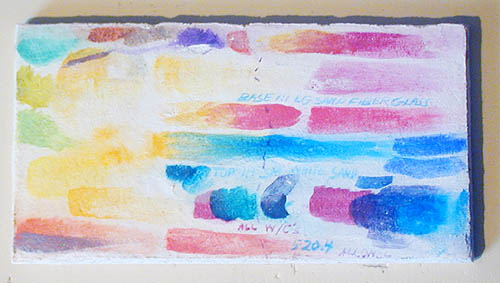
On the 8x8 three days later, after being wrapped in plastic, I rubbed through the top layer of carbonate that was making it waterproof and leveled off the surface again. While I was doing this I started molding the still malleable second layer into a bas-relief of a painting that was right there on the wall in front of me. It was a painting of where I am going to go tomorrow morning, 5-25-4.
Here's the painting.
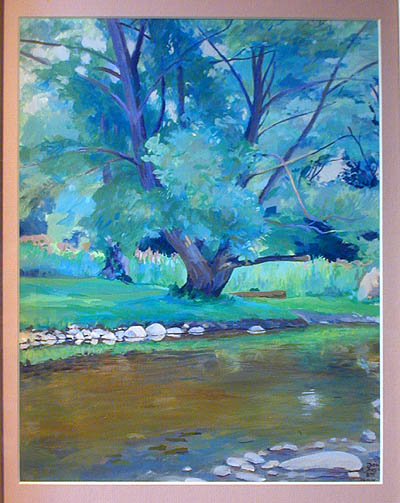
And here's the bas-relief.
I painted the color layout on location in acrylic and am painting the setting mortar with the water colors I think may be lime proof. Quinacridone magenta, Thalo blue, Thalo green, dioxine purple, transparent nickel complex Indian Yellow, cadmium yellow, hansa yellow, cobalt blue and cadmium orange.
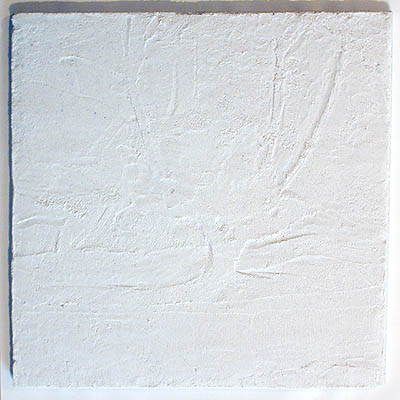
Because my pigments hadn't arrived yet from Maui, I did this test fresco with watercolors that may be permanent. They worked beautifully, the gum arabic will turn to dust just leaving behind the pigment.
Hmm... I've got $2000 worth of dry pigment to use up. This is it after 5 days drying. All the colors are locked in and all the colors seem to be lime safe, just like the dry colors. The white sand worked almost as well as white crushed limestone.
Here is the buon fresco, done with watercolor pigments three days after laying the intonaco coat.
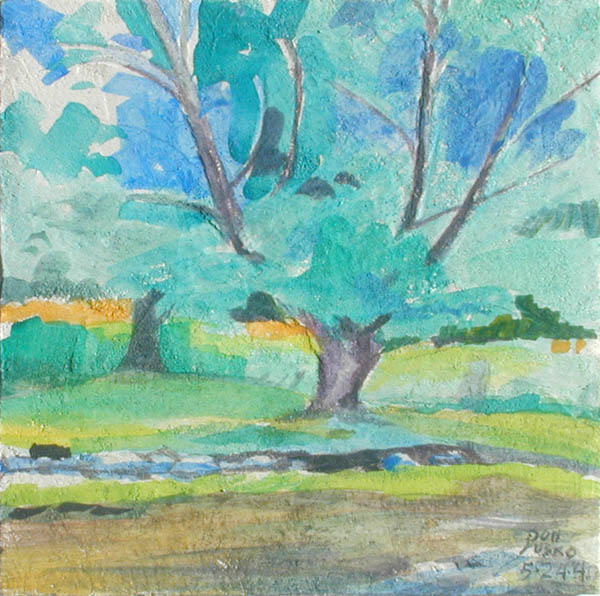
Two days later, the yellow green at the bottom was coming off on a wet cotton swab. That could have been because I added it hours after I was finished.
Tonight I'm going to test all my reds and magentas and alcohol medium. I will use three coats of thin pigment in each chip. The tile with intonaco I'm painting on was laid on 5-21-4 and kept in plastic..
Starting with my cad red replacement I know is lime proof.
1. Warm Quinacridone or Thalo Red stored in water, it can be used in alcohol, water or ammonia.
2. Cad Red, water.
3. D.S. Permanent red, water.
4. Quin Coral will not disperse in water but will in alcohol. So I painted it with alcohol. Too much alcohol will pit the lime.
5. Quin. Red paints with alcohol. Ammonia works almost as good.
6. Alizerin Crimson, stored in ammonia, paints well with ammonia or alcohol.
7. Quin. Violet, row 2, stored in alcohol, painted best with alcohol. A very neutral magenta.
8. Quin. Magenta, stored in ammonia, painted with ammonia. A cool magenta. doesn't soak in as well as Quin. Violet. It appears to have bled, but it's done with lime water washes.
9. Dioxazine Purple, next to Quin. Magenta, stored in ammonia. Painted with water.
10. Dioxazine Purple, stored in ammonia. Painted with ammonia.
11. Dioxazine Purple, stored in ammonia. Paints best in alcohol, much better color.
12. Quin. Violet and Thalo blue.
13. Cad Yellow and quin violet. Row 3
14. Cad yellow and quin. magenta stripe.
15. Senopia ult. blue and water.
16. Senopia ult. blue and alcohol.
17. Burnt sienna and water.
18. Burnt sienna and alcohol.
19. Dioxazine Purple and phthalo green make the color of the distance. Water.
20. Dioxazine purple and phthalo green and titanium white in alcohol.
22. Viridian paints best with water.
23. Viridian paints well in alcohol.
24. Viridian paints only fairly in ammonia.
25. Thalo Green, stored in alcohol, painted with ammonia.
26. Thalo Green, stored in alcohol, painted with water.
27. Thalo Green, stored in alcohol, painted with alcohol.
28. Thalo blue ammonia. In ammonia it changes color while wet and back when dry.
29. Thalo Blue water.
30. Thalo Blue, stored in alcohol, paints best with alcohol, bottom right corner.
31. Indian Yellow B/s, in water, see 32.
32. Indian Yellow B/s with titanium white in alcohol, A+. Some alcohol ran into the above Indian yellow.
33. Priderit Yellow is a light yellow-yellow green, I keep it in ammonia to guard against mold. Paints well in water, ammonia or alcohol.
34. Irgazine Green, stored in alcohol, painted with water. Dry the pigment on the palette first, alcohol and water don't mix.
35. Irgazine Green, stored in alcohol, painted with alcohol. It's a green-gold tranparent hue.
36. Indian Yellow B/s, paints best in alcohol. Left side, top Indian Yellow, Indian yellow and titanium white, column two, indian Yellow and alcohol.
37. W/C pigment with gum aribic, Indian yellow column three, water.
38. W/C pigment with gum aribic, Gamboge, column three, water.
5-25-4, Here is the alcohol medium instead of the lime water medium, buon fresco test. 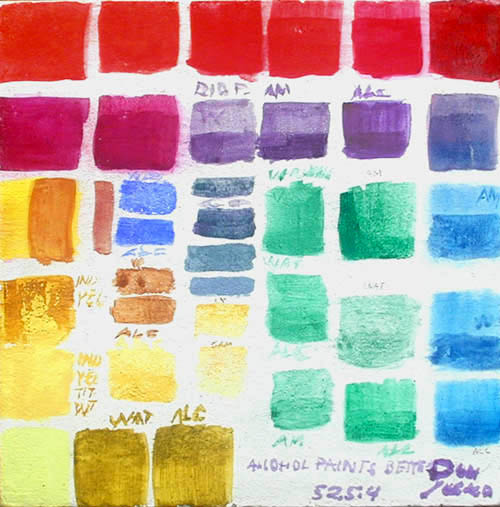
9-1-4, Sinopia's ultramarine blue dark, stabilized for oil, lime and cement was the only color that faded. Very sad, I had such high hopes for it. What this means to me is the only ultramarine hue to use is the phthalocyanine PB15.6 sold by Sinopia. It's not exactly as strong and pure as an ultramarine pigment but it won't stick out like a decoration either.
Here is the faded ultramarine blue and the PB15.6.
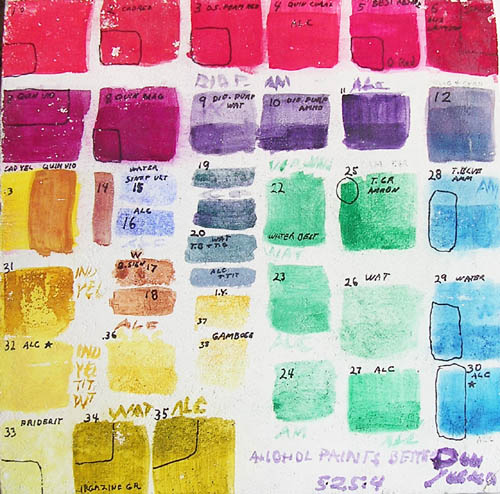
Here are the pigments with and without lime.
#1 = Sinopia PB15.3 a cyan hue
#2 = Sinopia PB15.1 a cobalt blue hue,
#3 = Sinopia PB15.6 an ultramarine blue hue.
#4 = Zecchi Phthalo blue is a cyan
#5 = PR122
#6 = Zecchi ultramarine blue
#7 = Sinopia stabilized ultramarine blue dark.
#8 = PG36 Haliogen green Y/s
#9 = Zecchi cobalt blue light
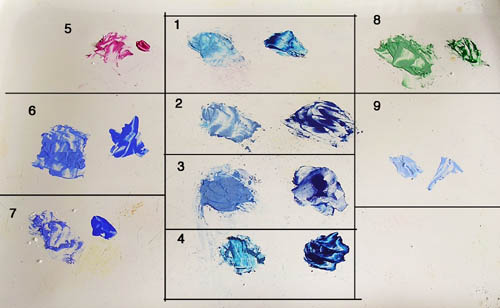
It seems to me that alcohol is the better media to paint in. Colors flow better, show better and the lime seems to accept the color better. Lime can be made in water or ispropyl 70% alcohol.
6-6-4, Colors applied with alcohol were smoother blends, the alcohol colors absorbed faster and more evenly.
Lime water or Alcohol as medium
5-7-4, I can't work on my afternoon acrylic color scaled cartoon painting because the sun isn't shinning. So I'm doing an alcohol, alcohol and limewater, limewater, test. I put the intonaco on the mortar test tiles, finished 5:30.
3 tiles,
#1, 6-2-4, Intonaco, Lime 1:2 small sand, showed too much color texture.
Brown, 2 medium sand, 1 lime with alum. A very nice Brown second coat. The even sand size will make removing extra intonaco easy.
#2,
6-7-4, Intonaco, lime 1:2 small sand. This ratio shows imperfections.
6-2-4, Brown coat, 1 med 1 small sand, 2 lime plus .001 alum. The addition of small sand caused problems while floating the brown coat, not rough enough.
#3,
6-7-4, Intonaco, lime 1:1 small white sand. Perfect intonaco, shows no texture and graduates colors smoothly with thin washes. The intonaco laid well over the large sand rough.
6-3-4, Rough, 1 large, 1 med sand, 1 mix of 70% lime 30% white cement. This is the Rough coat recipe I used on the large mural.
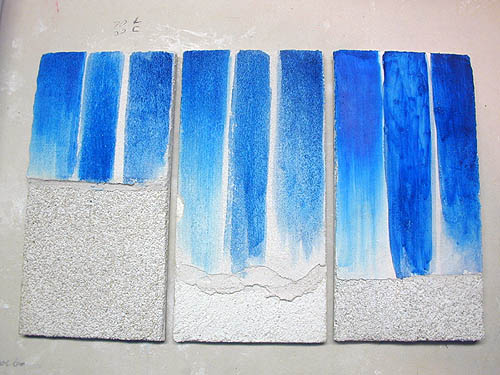
Left Line, Thalo blue with lime water
Middle Line, Thalo blue with 1:1 limewater and alcohol. I see right away this doesn't work well, you can see the effects of alcohol and water not mixing in the surface of each stroke.
Right Line, alcohol only. Painted the best, showed color best. As always, don't labor strokes, add the right amount of medium and pigment and make another stroke.
|








